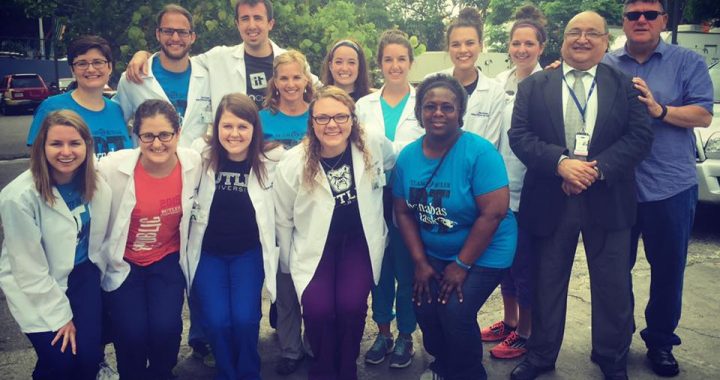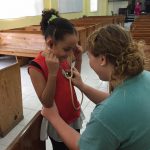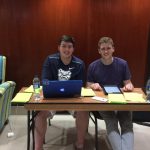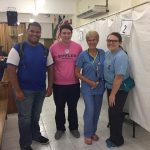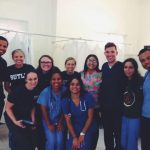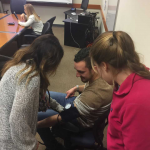This article is part of a new series of features on the work of our wonderful SENCER community members. NCSCE staff have the pleasure of corresponding with so many of you on a regular basis and are aware your efforts, but we realize that most members of our community may only have access to information about these great initiatives at our national or regional events. This series allows us to share the ingenuity and dynamic work of NCSCE participants and their partners with all of our readers. Each month, we’ll talk with educators, administrators, students, and/or staff to learn how they have implemented the SENCER approach, and how it has impacted their campuses and communities.
Butler University has been a leader in the SENCER community for years, supporting faculty in their creative implementation of the approach across the curriculum, organizing regional meetings, and hosting SSI 2011. Drs. Joseph Kirsch and Donald Braid are the co-directors for the regional SENCER Center for Innovation (SCI) – Central Plains, which provides local programming and guidance to complement national activities. At the recent NCSCE Science and Engineering for Social Good meeting, a team of faculty and students from Butler presented on an international project to develop an electronic medical record app to improve healthcare in the Dominican Republic. In this article, we hear from Butler University students about the impact of this experience. – Danielle Kraus Tarka
By: Courtney Cox and Sarah Lenahan
When you think of Butler University (BU), you may think of Butler Basketball or a cute live-mascot bulldog named Blue. Supporting technological developments in third world countries does not typically come to mind. And you definitely do not envision a few students leading this campaign. Since 2014, pharmacy and computer science students have been collaborating to create an electronic medical record (EMR) application to benefit a medical mission that the healthcare students undertake each summer. Our story includes three students from two colleges, collaborating to improve healthcare in a developing country through technology.
Since May 2014, BU has partnered with Barnabas Task, a nonprofit organization centered in Fort Wayne, IN, on medical mission trips to the Dominican Republic. After two years, the team, led by Dr. Trish Devine, recognized the need for a more efficient system for documentation and storage of patient information. This led to the idea of developing an EMR software application. With limited technological background, the healthcare team connected with computer science and software engineering students back at BU to begin a collaboration through the Engineering Projects in Community Service (EPICS) program.
EPICS, a course instructed by Dr. Panos Linos, focuses on pairing computer science and software engineering students with organizations from the community that need technological services, an emblematic SENCER strategy. While it gives students a great learning opportunity to work on real-world projects, it also benefits the organization as they gain a new technological platform to work with. Through this newly developed partnership between the EPICS and pharmacy students, the development of a prototype EMR was built as part of an iOS application. A few times per semester, the EPICS students met with the pharmacy students to update the team on any new developments in the application, further brainstorm ideas, troubleshoot any issues as well as test the application during mock clinic simulations. This course has truly helped Butler live out SENCER’s mission to engage more students in STEM programs and connect these programs with civic responsibility. To learn more about EPICS at Butler, visit epics.butler.edu.
Starting with the engineering of the application, Patrick Burns has been a key player in this project. He is a 4th year software engineering student at BU. During his 3rd year, he enrolled in the EPICS course offered at Butler and chose to be a part of the group working on an electronic medical record application. Patrick expanded his involvement by traveling to the Dominican Republic in May 2017 to help troubleshoot any on-demand problems. Patrick enjoyed his experience so much he has become the computer science student leader and will travel to the Dominican Republic with the healthcare team again in May 2018.
This story doesn’t end in the computer science department. With the development of a prototype EMR application, the students collaborated with healthcare students on campus to build the most functional application possible. With the help of a few pharmacy students, the application resembles real-life EMR systems in their most basic forms. Courtney Cox, a 4th year pharmacy student at BU, has traveled to the Dominican Republic for the past three years and has witnessed positive changes within the clinic with the introduction of the EMR. “I count myself as lucky that I have gotten to work on this application so closely in conjunction with the computer science department. Not only have I gained amazing friendships but these experiences have definitely dictated my future career goals as I hope to continue to travel abroad for medical missions in the future.” And then there is Sarah Lenahan. She is currently a 3rd year pharmacy student at Butler and has traveled to the Dominican Republic twice, with her third trip coming up in May 2018. “Working with computer science students and getting to know one another has led to lifelong connections along with a new appreciation for the amount of work which goes into the technological side of EMRs. I plan to continue developing the application with a hope that one day we will can provide the application to other non-profit medical groups who are helping to serve the poor. I am excited for my next adventure on the trip this summer and cannot wait to utilize some of the new functions within the application this year.” Sarah plans to pursue a career goal which will allow her to take care of the underserved within her community or abroad.
The relationships that the pharmacy and computer science students were able to form on campus made it possible to producing the best prototype EMR application possible, but the teams realized this partnership should not end with the course. The healthcare team was going to be reliant on this application while on their trip to the Dominican Republic and recognized the need for computer science students on the trip. Fortunately, every year since the inception of the EMR application, computer science students have joined the medical mission trip to continue the development of the application as well as work through any technological issues that may develop while abroad. “I simply can’t imagine what we would have done if they [computer science students] hadn’t come with us. Having them around when problems came up was a huge help,” says Courtney, during her 3rd medical trip to the Dominican Republic.
Students not only formed beneficial relationships with other Butler students; they also were able to connect with students from the Dominican Republic. According to a survey sent to all students involved in the trip and/or the production of the EMR application, students reported improvements in technical skills, communication, leadership, and cultural awareness. A majority of the EPICS students responded that they improved their technical sufficiency in areas of Swift and Xcode as well as non-technical skills including communication and teamwork. Healthcare students responded with a growth in skills including cultural awareness and collaboration between other healthcare providers as well as students of another major. Lastly, students from the Dominican Republic reported strengthening their English skills as well as learning about American culture. Overall, it was wonderful to see all of the different areas that students were able to grow and expand their knowledge because of this collaboration.
This project is still in its infancy stage and there is no plan to discontinue it. Each year, the application has expands it capabilities to include medication inventory, patient information storage, and overall format. Development will continue this spring and will continue with a new group in the fall. In the future, possible areas of development in the application include integrating medication interactions to flag to ensure patient safety and to also incorporate a statistics/analytics function to monitor our impact abroad. Furthermore, the clinic is rapidly expanding not only within the Dominican Republic but in other areas of the world, including Cuba. The possibilities are endless and we cannot wait to see where the application will go next. What collaborations can you envision that will to improve the world?
- Butler Physician Assistant students Lauren and Kaitlyn pose for a pharmacy picture with Kaeli and Thomas as well as an EPICS student, Jordan.
- Sarah Lenahan, a Butler pharmacy student, allows a young girl to try out a stethoscope.
- The dynamic IT duo of May 2017, Matt and Pat.
- Sarah and Matt work alongside Nancy, a nurse practitioner, as well as a Dominican student to assist with translation.
- Pharmacy and PA students chat with Deb, a nurse practitioner, as they prep the triage area of the clinic.
- A group of American and Dominican students prepping to head out into the community to provide health education.
- The healthcare students use the computer science department as mock patients as we trial the application.
Photographs courtesy of Sarah Lenahan

